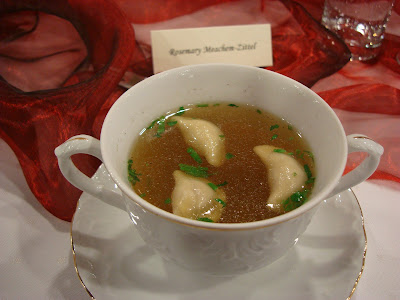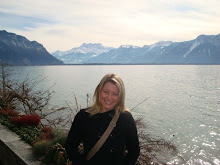The first thing I was surprised about was that the Krakow airport had only a handful of gates and a total of one baggage carousel. The second thing I was surprised about was the currency. Poland joined the EU in 2004 and has 38 million people, so I sort of assumed they had accepted the euro shortly after joining. It turned out that they still use the złoty (meaning golden), which dates back to the Middle Ages. The exhange rate to the US dollar while I was there was something around 3 to 1, so an item that cost 30 zloty equaled $10. Poland was still a cheap country by European standards, with beers costing around $3.00, main courses in a restaurant around $10-15, and 1 hr spa services $40.
Krakow managed to survive WWII unscathed, so the buildings are old and quaint, and the feel of the city is very bohemian and artsy. You can even still see some of the ancient wall that used to surround Krakow. The Main Market Square dates back to the 13th century, and at 430,000 ft² is the largest medieval town square in Europe. It is surrounded by historical townhouses, palaces and churches including the 10th century Church of St. Wojciech and St. Mary's Basilica, where a trumpet player stands at the window and re-enacts a scene from history, playing a solemn tune every hour on the hour, until the song ends abruptly halfway through when the trumpet player gets "shot."
Krakow had its fun and quirky traits, such as the hostel named Goodbye Lenin and the bar named Oldsmobile. I was awed by both the big and small - elaborate churches literally on every corner, a fresh fruit stand down a tiny alley, a clean white wedding dress in a store window of a black sooty building. Clergymen walking around in their long black robes, one with a leather jacket over his Cossack.
At the castle we saw the tomb of the late president tomb Lech Kaczynski and his wife Maria, who died in the tragic plane crash in April 2010. But Ula said that in Poland he wasn't really respected very much until he died tragically, and then he was touted as the greatest leader ever. The crash was eventually ruled as an accident, and no fault was blamed on any one person because no one actually insisted that they land.
After walking around the center with Ula and Karolina, we headed to the Jewish quarter. German authorities created the Jewish ghetto in Krakow under the Nazi occupation in early 1941 as a compulsory dwelling place for the city's Jews. Over two years of its existence several thousand residents of the Jewish ghetto in Krakow were either killed or died of hunger. Then the Nazis emptied Krakow's ghetto systematically in three waves, into the concentration camps Belzec, Plaszow, and Auschwitz. Steven Spielberg's famous film, Schindler's List, is based on the tragedy of the Jewish ghetto in Krakow.
On Sunday morning Ula picked me up and we headed for a small town an hour and a half outside of Krakow where the wedding was taking place. I asked, "Should I expect lots of vodka?" and was told, "Yes, at weddings there is always a lot of vodka." The roads and infrastructure in Poland are terrible, which I didn't believe until I saw it with my own eyes, so a drive of 200 km can take 5 hours. The main problems are that they have never invested in a freeway system throughout the country, so most of the roads are two-lane country roads, and that these roads that do exist are pitted with pot holes. Big, gaping potholes that threaten to crack the belly of the car.Apparently even the train system isn't good because they are not fast trains.
When we arrived at Joanna's house I got to help her finish getting ready and participate in the pre-wedding rituals. First, the groom and his family arrived at the bride's house and had to "buy her" out. The asking price was a good man, a good driver, and a case of vodka. The selling price was a good man and half a case of vodka. After some religious ceremonies between the two families at the house, everyone piled into cars and began the procession to the church caravan-style. Apparently when a wedding goes on like this, the local teenagers have unspoken permission to play pranks on the wedding party to make them late, so after a few blocks our wedding caravan was stopped by a roadblock of a broken down car blocking our path. The lead drive got out and bargained with the teenagers, who I heard received two bottles of vodka in exchange for moving the car out of the way.
The ceremony itself was very normal, a typical Catholic service (but all in Polish - I was mostly lost). Afterwards, the reception was held in a giant guesthouse nearby, with dinner for 120 people and accomodation overnight for around 20 of us. As we all sat down Joanna's father rolled out a cart of vodka cases and placed vodka bottles on each table, approximately one bottle for every 4 people. The vodka even had its own special glass, a sort of miniature champagne flute. Each table also had many pitchers full of different kinds of juices to help temper the vodka. Another tradition I learned was that at weddings the first dish is always chicken broth soup so that your stomach gets coated with a layer of fat before the vodka starts. Then they alternate drinking and eating, but always with heavy fatty food so that they can drink more. We had a full 3 course meal (chicken soup, chicken kiev with potatoes, and panna cotta) and immediately after that the waiters brought out huge platters of appetizers consisting of bread, cold cuts, and pastries for people to snack on. An hour later all the lights were turned off and a cart was wheeled out with sparklers shooting flames out of a large round object. I assumed it was cake time, but it turned out to be pork roast (at 11pm!). Sometime around midnight it was actually cake time. I went to bed close to 2am, but I heard the party continued until nearly 5am. We danced a lot, to a wide mix of songs including Polish circle dances, the can can, YMCA, the chicken dance, and Michael Jackson's Billie Jean.
On Monday afternoon Joanna and I headed to Warsaw, where she lived and where I was going to do work for two days before going back to Switzerland. In contrast to Krakow, Warsaw saw war. It was utterly devastated during WWII, with 90% of all buildings completely destroyed by the Nazis. The Polish rebuilt the whole city, including their churches and palaces, to look as they did before the war. However, the city has an eeriness to it because of this, with smooth painted concrete walls that are 50 years old trying to pretend that they are really 300 years old. Warsaw still had its own charm, though, especially the Old Town, with its brightly lit restaurants and fountains. We had the best duck I've ever had in my life at an outdoor cafe in the center of the Old Town.
The whole experience of Poland was surreal, like going backwards in time, especially when we were driving through the countryside watching farmers and their wives take a stroll through town, looking like they just stepped out of a 1940s photograph. Poland is definitely on its way up in the world, but still has a long way to go.
























No comments:
Post a Comment